If you’ve been to Korea, or simply eaten Korean food, then you definitely know kimchi. You might also recognize some other Korean side dishes, but why are they always there? Side dishes, known as banchan (반찬) in Korean, have a long history in Korea and remain a staple of local cuisine. With so many regional variations and contemporary recipes, you’ll never run out of new banchan to try. To help you get started on your banchan journey, we’ve comprised a list of the top 15 banchan along with a short recipe for you to try at home.
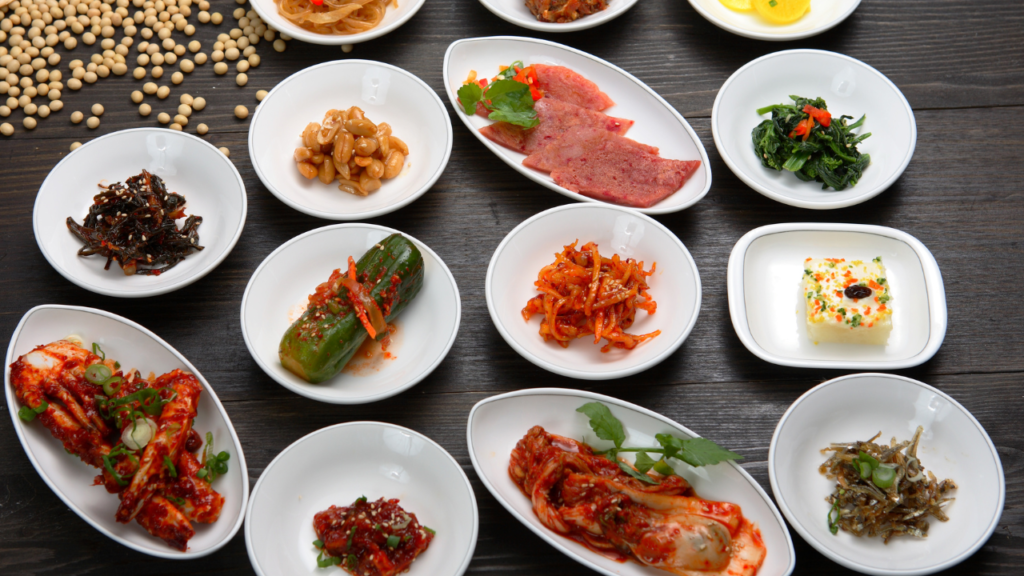
What Are Banchan?
Banchan (반찬) is the Korean word for small side dishes served alongside Korean cuisine. A basic table setting in Korea would include plenty of cooked rice, soup, red pepper paste, kimchi, and other banchan. Kimchi is just one kind of banchan, and most Korean households include around three to five banchan per meal.
Banchan is designed to be shared despite being served in small portions, but don’t hesitate to ask for more! The more formal a meal, the more banchan will be served. While banchan is eaten everywhere in Korea, Jeolla Province is particularly famous for its large consumption of banchan with each meal.
But why bother having so many side dishes? Korea is an agricultural country but faces harsh climates and a mountainous terrain, limiting the availability to livestock. To safeguard resources and ensure food all year round, fermented goods became a necessity on the peninsula. Most fermented Korean food comes in the form of grains or vegetables enriched with varying pastes, herbs, spices, and oils.
Gochujang (고추장), red pepper paste, is a particular favorite among Koreans. Gochujang enhances the flavor of what might otherwise be considered bland food. Mustard, doenjang (된장) (soy bean paste), as well as a mixture called Chojang (초장) – gochujang, honey, vinegar, and ground pine nuts – are popular additions to banchan.
Korean Banchan
There are hundreds of banchan available today. However, if you’re visiting a traditional restaurant, market, or family home, it’s almost guaranteed that you’ll see some recurring choices. We’re going to introduce you to 15 of the most beloved banchan in Korea, and give you a brief recipe to try at home. Be sure to tag us on your social media after cooking – we’d love to see what you whip up!
*PLEASE NOTE that all banchan should be kept refrigerated in an air-tight container for storage or fermentation (if noted by the recipe).
1. Kimchi (김치)
Kimchi is the most representative food of Korea as it’s the country’s national dish. Kimchi offers a beautiful flavor profile of spicy, sour, and even sweetness. More than its taste, kimchi is good for one’s health, as its rich with vitamins and minerals.
The fermented side dish originated in Korea round the 7th century, but it wasn’t until the 18th century that the spiciness of red pepper was a regular element in kimchi recipes.
There is a wide variety of kimchi depending on the region and one’s preference for vegetables. The most popular options are cabbage, radish, cucumber, green onions, and even garlic. As Koreans tend to eat kimchi every day, there’s never a lost opportunity to try a new variety.
The process of making kimchi, known as kimjang (김장) in Korean, is a family affair that many households take very seriously. It can be a long process – sometimes a pungent one – so make sure you have plenty of time and help when you try making this dish at home. You can find the recipe for just about every type of kimchi on various Korean cooking websites and channels.
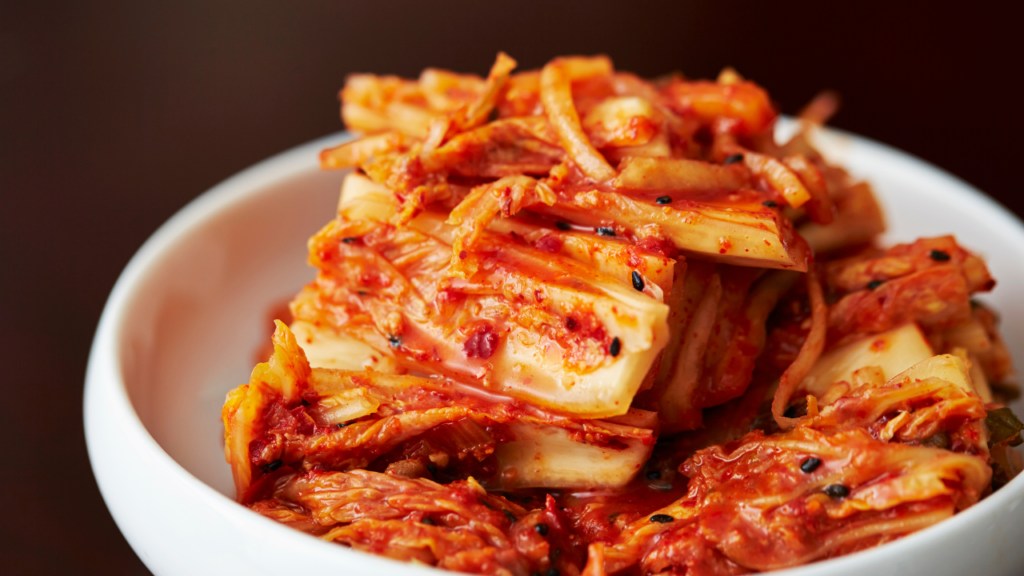
2. Bean Sprout Banchan (Kongnamul Muchim, 콩나물무침)
Bean sprout side dishes are immensely popular among Koreans due to their economical nature. Bean sprouts are a common vegetable in Korea and an entire bag of them can be purchased for around 2,000 won (2USD) in most grocery stores!
To make Bean Sprout Banchan, you’ll need:
1 pound of soybean sprouts
1 teaspoon kosher salt
2-4 (depending on your taste) garlic cloves, minced
1 green onion, shopped
½ teaspoon red pepper flakes
1 teaspoon roasted sesame seeds
2 teaspoons roasted sesame oil
Place the sprouts in a pot with the salt and ½ cup of water. Bring the water to a boil on medium heat and let the sprouts sit for 10 minutes. After draining, mix the sprouts by hand with the dry and wet ingredients.
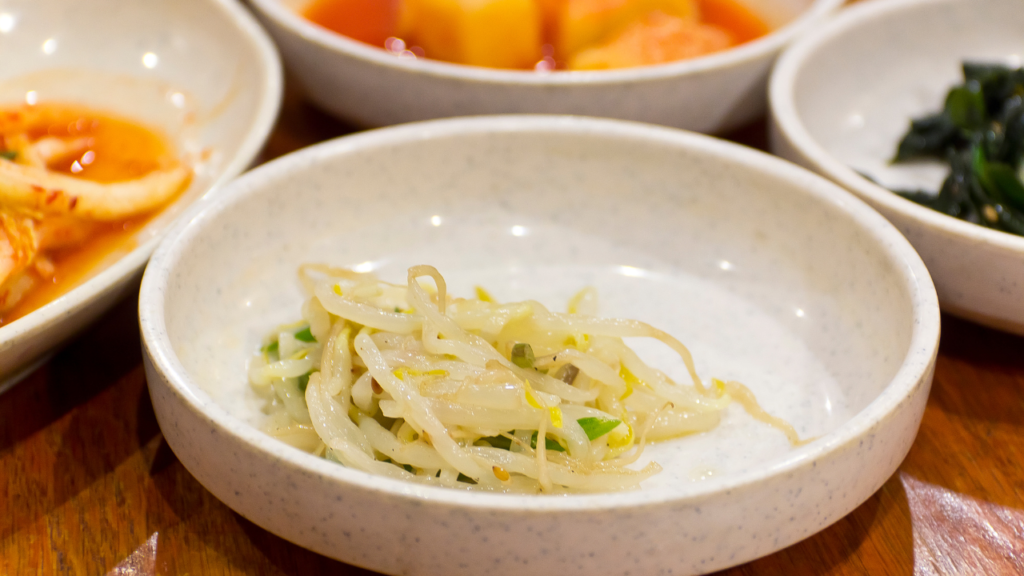
3. Sliced Radish Banchan (Musaengchae, 무생채)
Sliced radish banchan is made from firm, crunchy radishes with a sweet and spicy coating. It’s a common side dish that you can often buy pre-made in department stores, supermarkets, and markets.
To make Sliced Radish Banchan, you’ll need:
1 radish (preferably daikon or Korean)
1 tablespoon salt
1 tablespoon vinegar
2 teaspoons red pepper flakes
2 teaspoons sugar
2-4 cloves garlic, minced
1 green onion, chopped
1 teaspoon roasted sesame seeds
Peel and cut the radish into thin strips. Add the salt, mixing by hand, and let the radish sit for 5-10 minutes. Remove any excess water with a paper towel. Add the dry ingredients apart from the sesame seeds and mix by hand. Finally, mix in the sesame seeds.
4. Carrot Banchan (Danggeun Namul, 당근 나물)
Carrots don’t immediately stand out as a Korean vegetable of choice, which is why this banchan has a somewhat infamous reputation. Some claim that carrot banchan was actually invented by the Russians! We’re not entirely sure what’s true, but we do know that this side dish is relatively modern, having gotten its start in the 1980s.
To make Carrot Banchan, you’ll need:
1 pound fresh carrots, peeled
½ medium onion, thinly sliced
4-6 garlic cloves, chopped
¼ cup olive oil
3 tablespoons vinegar
½ juice from a lemon
1 teaspoon coriander seed, crushed
½ teaspoon salt
2 teaspoons sugar
½ teaspoon cayenne
Slice carrots into thin, long strips. Add the spices and garlic to the carrot. Slice the onion thinly and then cook in a skillet for around 1 minute on high heat. Toss the remaining ingredients together and let cool in the refrigerator for 1-2 hours.
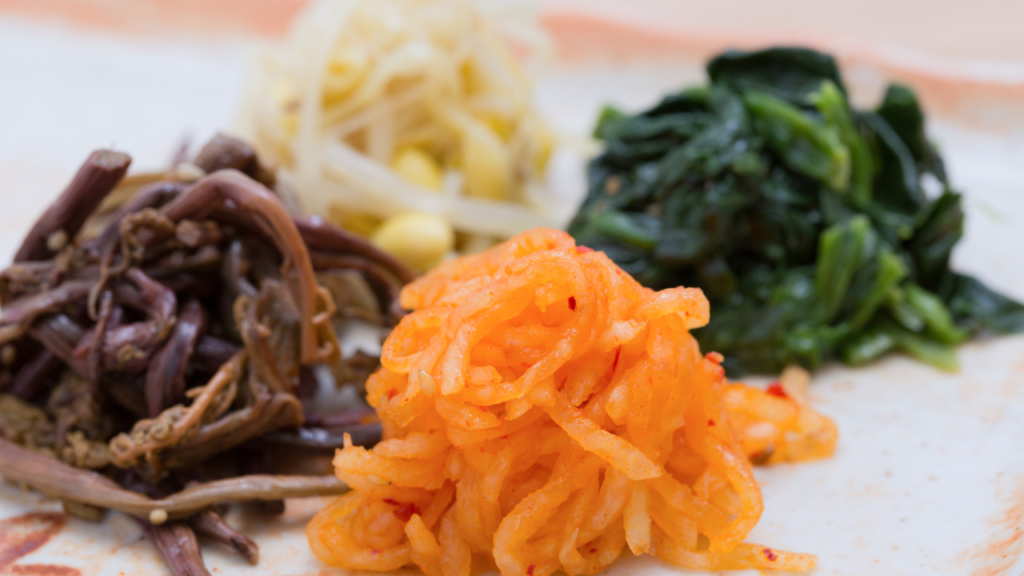
5. Mushroom Banchan (Neutari Bosot Bokkeum, 느타리버섯볶음)
Mushroom banchan is typically made with shitake, oyster, white button, or enoki mushrooms. This is a great banchan for vegetarians and vegans, as the juicy mushrooms tend to be more filling than other side dishes.
To make Mushroom Banchan, you’ll need:
2 pounds mushrooms of your choice
2 teaspoons salt
1 tablespoon toasted sesame oil
¼ teaspoon black pepper
2 teaspoons vegetable oil
2 tablespoons toasted perilla seed powder (toasted sesame powder)
½ small carrot, thinly sliced
⅓ cup garlic chives, sliced
Blanch the mushrooms in a pan for 1 minute. After washing, remove all excess water. Tear mushrooms to bite-size pieces. Add spices (except perilla seed powder) and mix well with a spoon. Return the mushrooms to a pan with high heat for about 1-2 minutes. Add perilla seed powder, carrots, and chives for one more minute.
6. Spinach Banchan (Sigeumchi Nameul, 시금치나물)
Spinach banchan is one of the most beloved side dishes in Korea with foodies appreciating its dual soft and crunchy texture. This bright green banchan goes particularly well with Korean BBQ.
To make Spinach Banchan, you’ll need:
8 ounces spinach
1 garlic clove, minced
1 green onion, shopped
1 ½ teaspoons soy sauce
1 ½ teaspoons toasted sesame oil
2 teaspoons toasted sesame seeds
Blanch the spinach in a pot of boiling water for 1 minute. Strain and rinse with cold water to remove dirt, squeezing out excess water. Cut spinach into bite-sized pieces. Mix in the remaining ingredients.
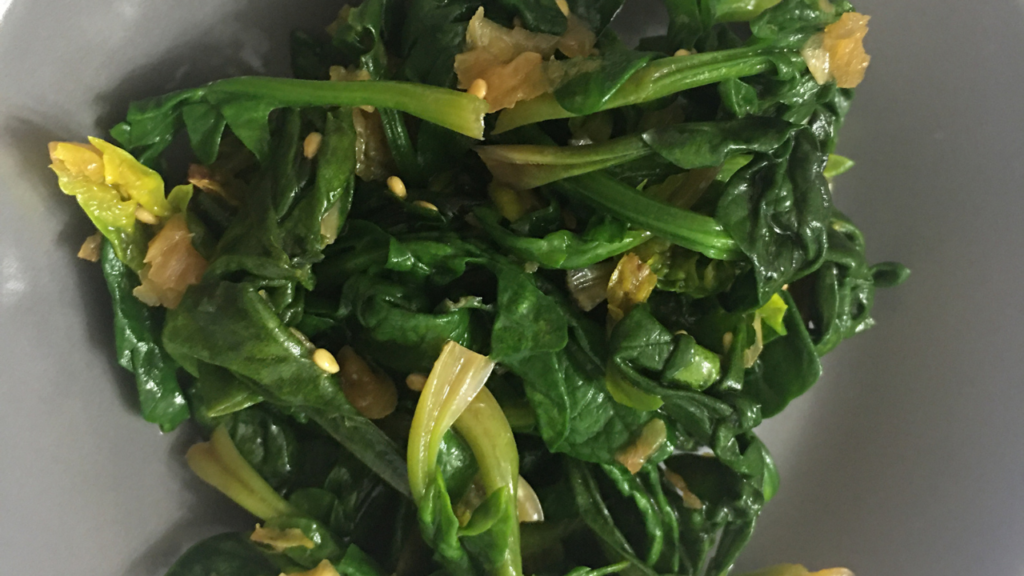
7. Cucumber Banchan (Oi Muchim, 오이무침)
Cucumber banchan is great for a lighter meal as it’s paleo, vegan, and keto friendly. The refreshing, clear taste of cucumber is a great contrast to spicy Korean meals.
To make Cucumber Banchan, you’ll need:
1 pound cucumbers, thinly sliced
1 clove garlic
1 teaspoon salt
1 teaspoon red pepper flakes
2 teaspoons toasted sesame seeds
2 tablespoons rice vinegar (apple cider vinegar)
2 teaspoons soy sauce
Slice the cucumber and place it into a bowl. Add salt to the slices and toss to coat. Let the mixture sit for 20 minutes. Remove any remaining water and add the remaining ingredients.
8. Pan-Fried Tofu Banchan (두부부침)
Another popular choice for vegetarians and vegans, pan-fried tofu banchan can be served warm or cold. The tofu’s soft texture mixed with a flavorful sauce goes together perfectly with rice – almost creating a meal with just the two of them!
To make Pan-Fried Tofu Banchan, you’ll need:
250g firm tofu
1 green onion, thinly sliced
2 tablespoon soy sauce
1 teaspoon sugar
1 teaspoon toasted sesame seeds
½ teaspoon toasted sesame oil
¼ teaspoon minced garlic
Drain the water from the tofu. Cut the tofu into squares just smaller than the size of your palm. Fry the tofu in a pan on medium heat for 4-5 minutes or until the tofu is a golden brown on both sides. Pour the remaining ingredients on top of the tofu in a bowl.
9. Steamed Egg Banchan (계란찜)
This bouncy, fluffy egg dish is both healthy and delicious. Steamed egg banchan might be compared to custard, and it goes well with nearly any Korean meal.
To make Steamed Egg Banchan, you’ll need:
4-5 large eggs
1 cup water (or anchovy broth)
¾ teaspoon salt
2 tablespoons chopped green onion
1 teaspoon sesame oil
½ teaspoon sesame seeds
Beat the eggs with a spoon and run the mixture through a sieve. Mix well with water and salt. Add the mixture to a small pot and let it simmer. When the eggs begin to set, mix and reduce the heat to low. Let it simmer for another 5-7 minutes, stirring occasionally. Add the green onion and drizzle the sesame oil and seeds on top.
10. Pan-Fried Potato Banchan (감자볶음)
Who doesn’t love potatoes? Potatoes are common in many cuisines around the world and Korea is no exception. These pan-fried potatoes are one of the more filling starters on our list, and therefore go great with soups and lighter meals.
To make Pan-Fried Potato Banchan, you’ll need:
2 medium potatoes
1 tablespoon oil
1 garlic clove, minced
½ small onion, thinly sliced
½ small carrot, thinly sliced
2 green onion, thinly sliced
1 teaspoon salt
1 teaspoon pepper
2 teaspoons toasted sesame seeds
Peel, wash, and slice the potatoes into thin strips. Drain the potatoes of excess water. On medium heat, cook garlic for 10-30 seconds. Add the potatoes and mix well for 1 minute. Cover and let simmer for 2 minutes on low heat. Raise the heat to medium and add the carrot and green onion, seasoning with salt. Cook for 2-3 minutes, keeping an eye on the potatoes to not break or brown. Sprinkle the sesame seeds and pepper, and serve warm.
11. Anchovy Banchan (Myeolchi Bokkeum, 멸치 볶음)
Anchovy banchan can be served spicy or sweet, and its multi-layered texture makes this dish a popular food even outside of seafood restaurants. For today’s recipe, we’ll focus on the sweet version.
To make Anchovy Banchan, you’ll need:
1 cup dried anchovy
1 tablespoon oil
2 green chili peppers, chopped
½ tablespoon soy sauce
2 tablespoons rice wine
2 teaspoons sugar
1 tablespoon corn syrup
3 garlic cloves, sliced
1 teaspoon toasted sesame oil
1 teaspoon toasted sesame seeds
Heat oil in a pan over medium heat. Fry the anchovies for 2-3 minutes and move to a bowl or plate. In the same pan, add all seasoning except sesame oil and seeds to the pan. Boil over medium heat until bubbles appear. Turn off the heat and add the anchovies and peppers to the pan, mixing well.
12. Shredded Squid Banchan (Ojingoechae Muchim, 오징어채무침)
This banchan is a favorite among students, as it’s one of the cheaper and simpler recipes on our list. The squid’s crunchy yet juicy texture makes it a great substitute for kimchi.
To make Shredded Squid Banchan, you’ll need:
1 pound dried squid, shredded
½ cup red pepper paste (gochujang)
4 cloves minced garlic
½ cup oil
⅓ cup corn syrup
2 tablespoons toasted sesame oil
Mix the ingredients apart from the squid together in a bowl. Mix in the shredded squid. Sprinkle roasted sesame seeds when serving for added flavor.
13. Chili Pepper Banchan (Gochujangajji, 고추장아찌)
This is a popular side dish, but it is different from the others on our list as it’s a type of pickle. Thus, this recipe might take a bit more time to prepare. Chili peppers are a staple vegetable in Korean cuisine and are enjoyed all-year round.
To make Chili Pepper Banchan, you’ll need:
1 pound green chili peppers
3 ½ cups water
½ cup soy sauce
¼ cup salt
¼ white vinegar
3 tablespoons sugar
Cut the top of the pepper stem, leaving a short stalk. Using a toothpick, make a hole just under the stem. Put the peppers into air-tight glass jars, waiting to seal. In a pot, combine the remaining ingredients over medium heat and stir until the sugar is dissolved. When the mixture bubbles a lot on the surface, pour it into the jar of peppers. Keep the peppers soaked in by placing a bag of weighted stone or other material inside the jar, on top of the peppers. Let sit at room temperature for 24 hours and then remove the liquid back into the pot. Boil the liquid for 15 minutes. Let it cool before pouring back into the jar. Cover with the air-tight lid and refrigerate for 1 week minimum before eating.
14. Zucchini Banchan (Hobak Bokkeum, 호박볶음)
Often confused with Cucumber banchan, zucchini is similar in taste, but much softer in texture. This bright-green or yellow banchan is often served in the summer when the zucchini season reaches its peak.
To make Zucchini Banchan, you’ll need:
1 medium zucchini
2 teaspoons salt
1 teaspoon garlic, minced
1 green onion, chopped
1 teaspoon toasted sesame oil
1 teaspoon toasted sesame seeds
1 tablespoon oil
Cut the zucchini in half (length-wise) and cut crosswise into ⅓ inch thick pieces. Heat an oiled pan over medium heat and add the zucchini, garlic, and salt. Cook for 2-3 minutes, continuously stirring, before adding 2 tablespoons of water. Add the green onion, sesame oil, and sesame seeds. Cook for 2-3 minutes, avoiding the zucchini turning brown.
15. Perilla Leaf Banchan (Kkaenipjjim, 깻입찜)
Don’t let the simple appearance of perilla leaf fool you – it’s flavor is nothing less than powerful. With the help of Korean spices, this banchan is one of the most stimulating for your taste buds. Perilla leaf is used in many Korean meals, but is most commonly consumed as a banchan.
To make Perilla Leaf Banchan, you’ll need:
60 leaves, washed and dried
2 garlic gloves, minced
2 green onions, chopped
4 oz. peeled onion, minced
2 tablespoons soy sauce
1 tablespoon toasted sesame seed oil
1 tablespoon toasted sesame seeds
2 teaspoons red pepper flakes
3 tablespoons water
In a bowl, combine everything apart from perilla leaves. Place about 30 perilla leaves in a shallow pan – stacked on top of one another – and add about 1 tablespoon of the sauce to the top of each leaf. Place the remaining perilla leaves on top in the opposite direction, adding the sauce to each leaf. Pour any remaining mixture on top of the stack of leaves. Cook for 3 minutes over medium heat and then remove from the stove, letting it sit for an additional 3 minutes. It can be served warm or cool.
